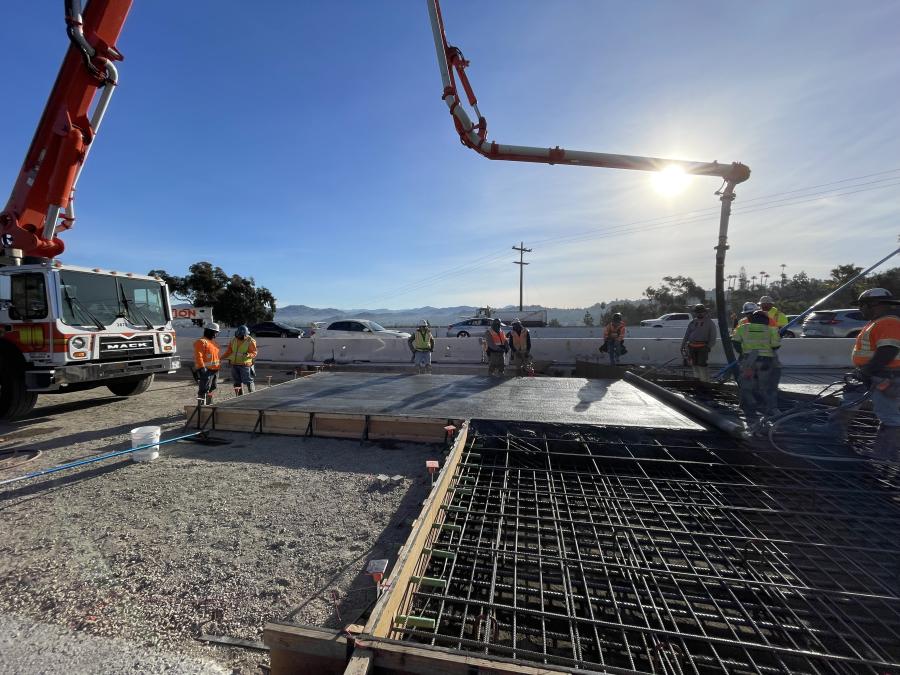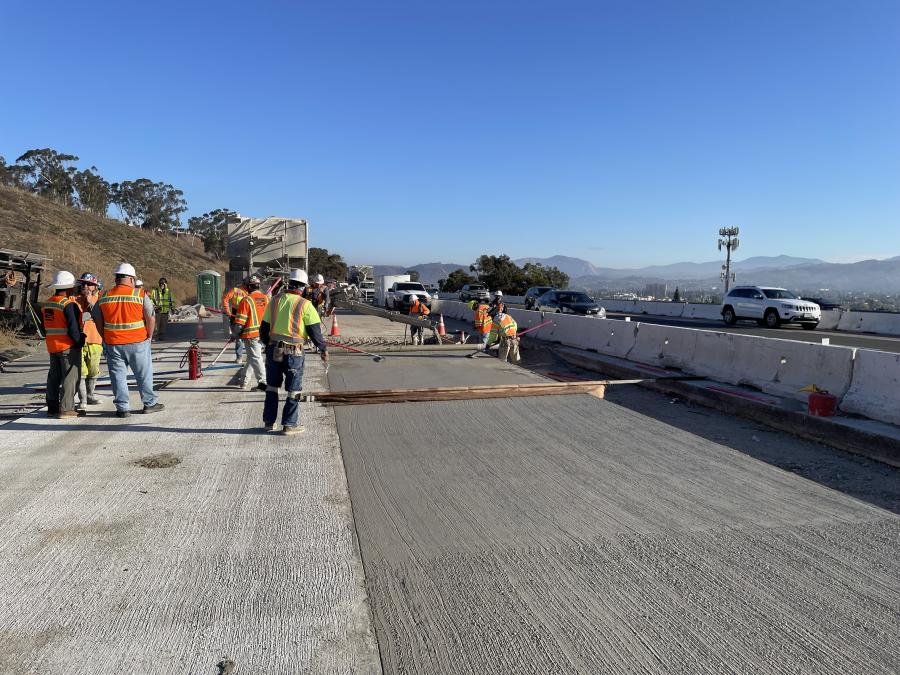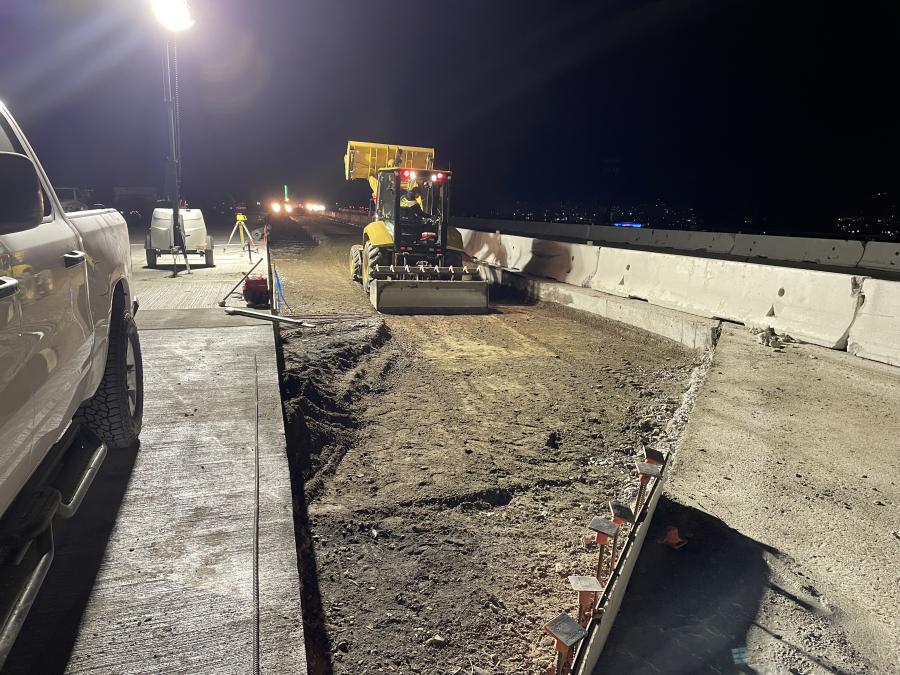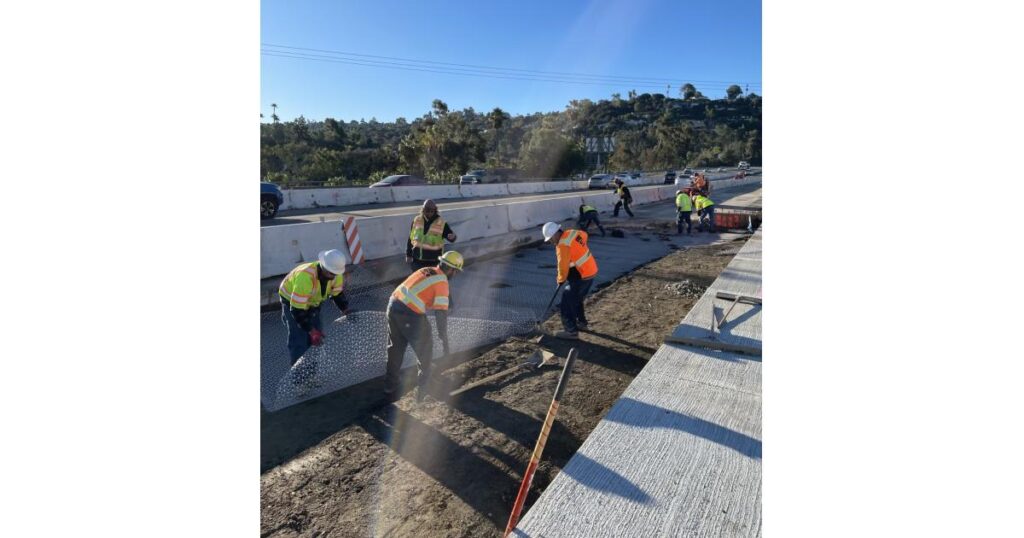Photo courtesy of Caltrans
Construction for the project began in November 2022 and is expected to be complete this summer.
The California Department of Transportation’s (Caltrans) $27.7 million I-8 Pavement and Bridge Rehabilitation Improvement Project in San Diego County — from El Cajon Boulevard to Marshall Avenue — began in November 2022 when crews from the Griffith Company broke ground at the 125/94 connector to execute the work.
“This project will extend the service life of several bridges along this stretch of Interstate 8 in East County by replacing aged pavement, installing concrete railings, sign replacements, landscaping enhancements and other road-enhancing features,” said Hayden Manning, a public relations officer of Caltrans District 11. “The result will give motorists a smoother ride, support efficient goods movement, reduce future maintenance and construction efforts, and ensure safe travels for all interstate motorists.”

Photo courtesy of Caltrans
The 6-mi. work zone started at the corner of La Mesa and Spring Street and will proceed on a linear basis to the end point at the corner of El Cajon and Mollison Avenue, passing through two interchanges — one at SR 125 and another at SR 67. I-8 has four lanes in each direction.
The Griffith Company expects to deliver the project this summer.
Construction crews began at the El Cajon overcrossing, followed by the Marshall Street overcrossing.
“The project is replacing the surface bridge decks to ensure a smoother road surface and install new concrete railings to enhance safety further,” said Manning. “New lane markings/striping is also being implemented. Landscape improvements are being made on adjacent banks near these projects, and these will prevent further erosion that may occur over time. We’re also utilizing Polyester Polymer Concrete [PPC]. The overlay material is designed to protect bridge decks and reduce long-term maintenance costs, reducing impacts on the traveling public and exposure for highway workers. In addition, landscaping will be updated to improve erosion quality improvements and new rail installations.”
Construction Scope
To this point, the Griffith Company has completed three out of six stages of construction on the project, consisting of bridge deck rapid strength concrete (RSC) pours for a 4.5-in. overlay and overhang replacement, approach slab replacement and jointed plain concrete pavement (JPCP) conform replacement on approximately half of the freeway. The remaining work consists of the same scope of work on the remaining half of the freeway, as well as replacement of the previously removed 4,500 ft. of center barrier and an overhead sign structure.
“This work is being completed in stages,” said Janelle Clanton of Caltrans’s structure construction division. “Because the deck overlay requires the existing polyester concrete surfacing to be removed prior to placement of new/additional deck rebar, it cannot be completed in a typical overnight shift and instead needs to be completed behind k-rail barriers. This means that traffic needs to be detoured, either by utilizing smaller lanes or by shifting traffic into the median temporarily.

Photo courtesy of Caltrans
“The existing bridge deck surfacing [polyester concrete] has been removed by micromill,” she added. “The existing bridge overhang and barrier has been removed after installation of falsework and a protective cover to prevent any debris from falling. This is especially important because we have a road, sidewalks and railroad tracks underneath. We have coordinated the work closely with the rail owners to ensure that there are no issues.”
The old concrete is being removed to the contractor’s yard, and a majority of the debris has been broken up using a crusher system.
“Removal of the existing polyester concrete surfacing can be done fairly quickly [within one overnight shift], however, sometimes there are remnants of the material which need to be removed with means such as hand tools, which can add time,” said Clanton.
The new deck lanes are not being opened to traffic after they cure.
“[This is] because we are completing a deck pour as well as replacement of approach slabs and of the JPCP conforms,” said Clanton. “We have been able to complete a lane within an 80-hour-long closure, but that is not the standard for the project. Most work is completed behind k-rail barriers over weeks or months, especially due to the other non-bridge work being completed on the project.”
The concrete pours on the decks are based on one bridge deck pour, one approach slab pour, and two JPCP pours per-lane.
“Polyester polymer concrete takes approximately two hours to fully cure after placement,” said Clanton. “The polyester concrete lift will be a minimum of 1-inch thick and will be placed on top of the 4.5 inches of RSC bridge deck concrete.”
For the deck work, crews are using concrete mix trucks and pumps, micromills, excavators, backhoes, loaders, rollers and forklifts.
Concrete railings are being installed throughout the project.
“We have already completed the railing installation on one side of the bridge, and will be placing the center railing within the next month or so,” said Clanton. “The barrier/railing needs to be completed after almost everything else has been, so we have had to make sure that all other portions of the work are done and ready to go.”
The railings are cast-in-place using forms.
Equipment-wise, crews are using steel forms, concrete trucks and concrete pumps. For the barriers in the center of the freeway, a slip-form/extrusion method will be used.
Approximately 150 ft. of concrete roadway on either side of the bridge is being replaced in order to conform the profile of the roadway to the new bridge deck, which is higher than before.
Griffith is replacing one overhead sign structure, as well as a few sign panels, on existing posts in the area.
“The removal of the structure has already been completed using a full freeway closure for eight consecutive hours,” said Clanton. “A crane was used to remove the truss, then the posts. Eventually, the remaining concrete post foundations were removed to 5 feet below the ground. To replace the sign, the cast-in-drilled holes sign-post pipes will be drilled/poured, then another full freeway closure will be used and a crane will place the sign structure.”

Photo courtesy of Caltrans
The work on the landscaping enhancements has not begun.
The Griffth team includes General Foreman Kyle Litten, Area Superintendent Woody Daigle, Project Manager Brittney Gomes, Project Engineer Michael Martin and Area Manager Brad Olson.
Subcontractors include SoCal Traffic for traffic control; BC Traffic for roadway signs; G&F Concrete for concrete demolition; Select Electric for electrical work; Cooper Engineering for center concrete barrier; Dees Burke for bridge barrier; and ACE Fence for MGS and chain link railing.
Figures for the demolition and excavation debris have not been finalized.
“The removed concrete from the existing roadway and center median barrier was crushed to be reused as Class 2 aggregate base on other projects,” said Clanton, who noted that the amounts of new materials are still being tabulated.
The Grifith company is meticulous about maintenance, ensuring that immediate repairs are done rapidly and that the routine maintenance schedule is strictly adhered to.
The company purchases and rents equipment from local and regional dealerships.
The financing includes $20.6 million in federal funds and $4.1 million from SB-1.
The project was designed by Maintenance Engineering/Bridge Asset Management and SM&I Design and Analysis, with extending the service life of the infrastructure as a priority.
Safety for the traveling public and construction workers is “priority number one” for Caltrans. Measures to achieve this include reducing the speed limit to 55 mph in the construction zone, placing advanced warning traffic signs, placing reinforced concrete barrier and having California Highway Patrol and freeway service patrol on-site, as well as a tow service. CEG
Read the full article here











